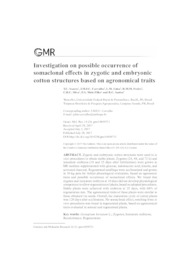Investigation on possible occurrence of somaclonal effects in zygotic and embryonic cotton structures based on agronomical traits.
Investigation on possible occurrence of somaclonal effects in zygotic and embryonic cotton structures based on agronomical traits.
Author(s): SOARES, T. C.; CARVALHO, J. M. F. C.; LIMA, L. M. de; FREIRE, R. M. M.; SILVA, C. R. C.; MELO FILHO, P. A.; SANTOS, R. C. dos
Summary: Zygotic and embryonic cotton structures were used in in vitro procedures to obtain stable plants. Zygotes (24, 48, and 72 h) and immature embryos (10 and 25 days after fertilization) were grown in MS medium supplemented with glucose, indoleacetic acid, kinetin, and activated charcoal. Regenerated seedlings were acclimatized and grown in 10-kg pots for further phenological evaluation, based on agronomic traits and possible occurrence of somaclonal effects. We found that zygotes and immature embryos at 10 days did not develop physiological competence to allow regeneration of plants, based on adopted procedures. Stable plants were achieved with embryos at 25 days, with 68% of regeneration rate. The agronomical traits of these plants were similar to those obtained via seeds. Overall, the maturation cycle of cotton plants was 120 days after acclimation. No somaclonal effect, resulting from in vitro procedures was found in regenerated plants, based on agronomical traits evaluated in normal and regenerated plants.
Publication year: 2017
Types of publication: Journal article
Unit: Embrapa Cotton
Keywords: Algodão, Algodão embrionário, Cotton, Gossypium hirsutum, Semente
Observation
Some of Embrapa's publications are published as ePub files. To read them, use or download one of the following free software options to your computer or mobile device. Android: Google Play Books; IOS: iBooks; Windows and Linux: Calibre.
Access other publications
Access the Agricultural Research Database (BDPA) to consult Embrapa's full library collection and records.
Visit Embrapa Bookstore to purchase books and other publications sold by Embrapa.

